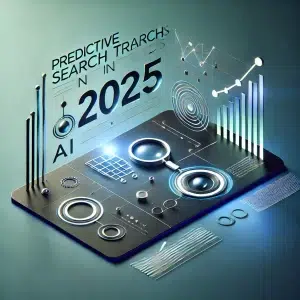Introduction: The Rise of Predictive Search Trends
Predictive search is revolutionizing how users interact with search engines. By leveraging AI and machine learning, search engines can anticipate user intent, delivering relevant results before a query is fully formed. As we approach 2025, understanding predictive search trends is essential for staying ahead in the evolving landscape of search engine optimization (SEO).
What is Predictive Search?
Definition and Importance
Predictive search refers to the use of AI-driven algorithms to anticipate and suggest search queries or results based on:
- User behavior.
- Search history.
- Contextual signals like location and device.
Why It Matters
- Enhances user experience with faster, more accurate results.
- Helps businesses reach audiences more effectively.
Key Predictive Search Trends for 2025
1. AI-Powered Suggestions
- Search engines like Google and Bing use AI to refine auto-complete and suggested results.
- Tools like ChatGPT are integrated for conversational search queries.
2. Voice Search and Predictive Insights
- Voice queries are inherently predictive, focusing on natural language.
- Example: “Where is the nearest coffee shop?” instantly delivers location-specific results.
3. Personalization through Machine Learning
- Search engines customize results based on:
- Past searches.
- Preferences.
- Geographic location.
| Trend | Impact on SEO |
|---|---|
| AI-Powered Suggestions | Increases accuracy of query targeting. |
| Voice Search Growth | Emphasizes conversational content. |
| Personalized Results | Demands user-centric optimization. |
4. Integration of Visual Search
- Predictive algorithms analyze images for context and relevance.
- Platforms like Pinterest and Google Lens lead this trend.
How to Optimize for Predictive Search
1. Leverage AI Tools
- Use tools like SEMRush and AnswerThePublic to identify trending queries.
- Integrate predictive analytics platforms.
2. Create User-Centric Content
- Focus on intent-based content.
- Incorporate long-tail keywords that match conversational queries.
3. Enhance Mobile Experience
- Optimize for mobile-first indexing.
- Ensure fast-loading pages and responsive design.
4. Incorporate Structured Data
- Use schema markup to provide search engines with context.
- Highlight FAQs, reviews, and product details.
Table: Predictive Search Optimization Checklist
| Task | Action |
| Research Trending Queries | Use AI-driven keyword tools. |
| Optimize for Voice Search | Create conversational, question-based content. |
| Leverage Structured Data | Add schema markup for key information. |
| Improve Mobile UX | Ensure fast and responsive mobile designs. |
Key Takeaways
- Predictive search leverages AI and machine learning to anticipate user intent.
- Optimizing for predictive trends requires a focus on user intent, personalization, and structured data.
- Adopting these strategies ensures businesses remain competitive in the evolving SEO landscape.
FAQs
What is predictive search?
Predictive search uses AI to anticipate and suggest search queries or results based on user behavior and contextual signals.
Why is predictive search important for SEO?
It enhances user experience, driving more accurate and personalized results while helping businesses target users effectively.
How can I optimize for predictive search?
Focus on intent-based content, use structured data, and optimize for voice and mobile search.
Which tools help with predictive search optimization?
Tools like SEMRush, Google Trends, and AnswerThePublic are excellent for identifying and optimizing trending queries.
Conclusion
Predictive search trends are shaping the future of SEO by prioritizing personalization, accuracy, and user intent. By adopting strategies aligned with AI-driven technologies and machine learning, businesses can ensure they stay ahead in 2025 and beyond. Embrace predictive search to enhance visibility, engagement, and user satisfaction.


